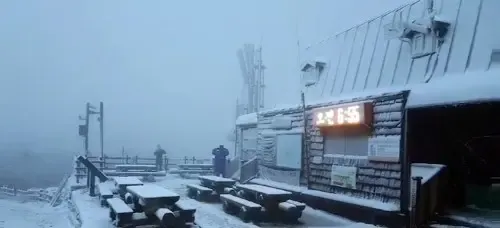South Korea Faces Heavy Snowfall, Alert Issues

Synopsis
Key Takeaways
- Heavy snow and rain affecting South Korea
- Weather alerts raised during Lunar New Year
- Significant snow expected in various regions
- Flight delays reported at Jeju International Airport
- Government mobilizes resources for safety
Seoul, Jan 27 (NationPress) Intense snowfall and rain impacted numerous regions of South Korea on Monday during the prolonged Lunar New Year festivities, leading authorities to elevate the weather warning and prepare for potential disruptions.
This year’s Lunar New Year celebration, referred to as Seol, was extended to six days, continuing until Thursday, after the government declared Monday a temporary national holiday.
In the greater Seoul area, parts of Gyeonggi Province, and southern areas, a snowfall accumulation of 10 to 20 centimeters is anticipated until Wednesday, according to the Korea Meteorological Administration (KMA).
In certain regions, like Gangwon's inland and mountainous zones, eastern North Jeolla Province, and the southern island of Jeju, snowfall could surpass 30 centimeters, as per the KMA.
A snowfall advisory is issued when at least 5 centimeters of snow is projected within a 24-hour timeframe.
As of 6 p.m., more than 100 flights at Jeju International Airport were delayed, with 10 cancellations attributed to severe snow and strong winds, as reported by Yonhap news agency.
The Ministry of Interior and Safety announced that the Central Disaster and Safety Countermeasure Headquarters has been activated.
Acting Interior Minister Ko Ki-dong directed relevant agencies to deploy all personnel and resources to mitigate damage from the heavy snowfall and implement strategies to alleviate traffic congestion as millions return to their hometowns for one of the nation's key traditional celebrations.
In light of the predictions, the Seoul metropolitan government has also escalated its alert to the second-highest tier.
A total of 9,685 workers, along with 1,424 snow-clearing vehicles and equipment, have been mobilized to ensure public safety and minimize disruptions.
Lunar New Year marks the commencement of a new year according to lunar calendars or, more commonly, lunisolar calendars. While both calendar types typically begin with a new moon, lunar calendars maintain a fixed number (usually twelve) lunar months, whereas lunisolar calendars vary, periodically resetting to align with the solar year.
This event is celebrated by various cultures in distinct manners on different dates. The method for determining the first day of a new lunar or lunisolar year differs among cultures.









